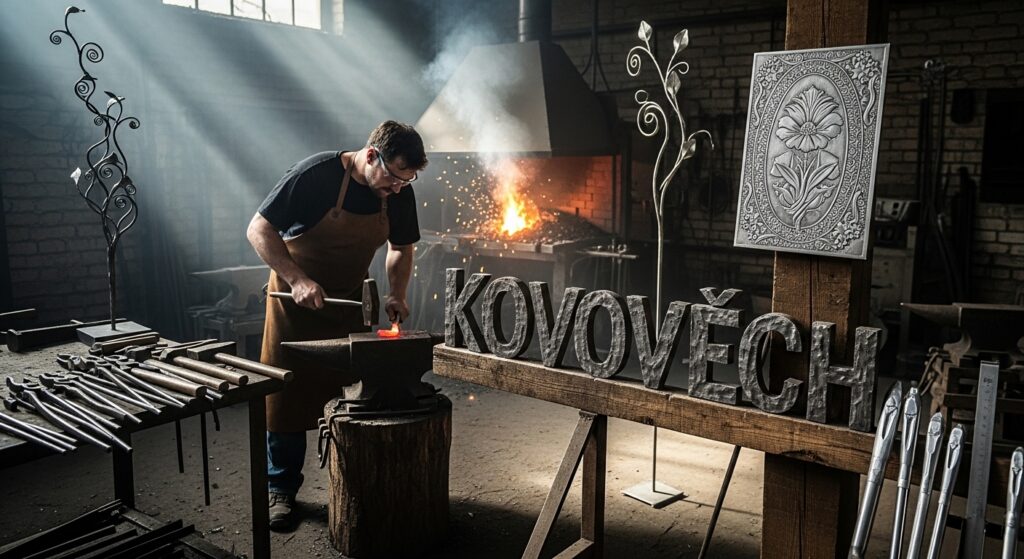The term Kovových is rooted in the Czech language, meaning metal or metallic, and it carries a deep significance across industries like construction, design, and manufacturing. In today’s evolving industrial landscape, Kovových represents not just the strength of metal but also the artistry, innovation, and sustainability behind its use. From traditional blacksmithing to advanced 3D metal printing, Kovových craftsmanship has transformed the way we build and create.
This article explores the origins, applications, and modern trends of Kovových, giving insight into how this powerful material continues to shape our world.
The Historical Significance of Kovových
Metal has always been a symbol of strength and endurance. The concept of Kovových dates back centuries, when early civilizations forged tools, weapons, and art from natural ores. These early techniques laid the foundation for modern metallurgy and manufacturing.
| Era | Key Development in Kovových Craft | Impact |
|---|---|---|
| Ancient Period | Discovery of bronze and iron | Led to the Bronze and Iron Ages |
| Medieval Period | Rise of blacksmiths and metal armor | Enhanced defense and toolmaking |
| Industrial Revolution | Mass production and steel innovation | Transformed construction and transport |
| Modern Era | Automation and alloy advancements | Enabled stronger, lighter, sustainable metals |
The progression of Kovových technologies reflects human creativity and the constant pursuit of innovation.
Kovových in Architecture and Construction
In architecture, Kovových materials are valued for their durability and flexibility. Whether used in structural frameworks, decorative elements, or facades, metalwork adds both strength and aesthetic value.
Steel and aluminum—two key forms of Kovových—dominate the construction industry. They allow engineers to design skyscrapers, bridges, and public structures that stand the test of time.
Architects also explore Kovových designs for sustainable building practices. For example, recycled steel reduces environmental impact and maintains the same level of strength as newly produced material. The lightweight yet sturdy nature of aluminum makes it ideal for energy-efficient buildings and green architecture.
The Artistic Essence of Kovových
Beyond functionality, Kovových holds immense artistic appeal. From intricate sculptures to modern furniture, metal artistry demonstrates how hard materials can express creativity and emotion.
Artisans and designers have long admired Kovových for its versatility. Metals like brass, copper, and stainless steel can be molded, polished, or aged to achieve different visual effects. Many contemporary artists combine traditional metalworking with digital design tools, producing pieces that blend classic craftsmanship with futuristic aesthetics.
For instance, the use of Kovových in public sculptures and urban installations connects art with environment, creating cultural landmarks that inspire communities.
Kovových in Industrial Manufacturing
In manufacturing, Kovových components are indispensable. Metals are used in vehicles, electronics, machinery, and countless everyday objects. Precision engineering relies heavily on the strength and adaptability of metallic materials.
Key areas where plays a vital role include:
-
Automotive Industry: Car frames, engines, and safety systems depend on steel and aluminum alloys.
-
Aerospace: Aircraft require lightweight yet durable structures like titanium.
-
Electronics: Copper and gold are used for wiring and microchip connections.
-
Energy Sector: Wind turbines, pipelines, and solar panels rely on metallic frameworks for stability.
| Industry | Primary Kovových Used | Purpose |
|---|---|---|
| Automotive | Steel, Aluminum | Strength, safety, efficiency |
| Aerospace | Titanium, Aluminum | Lightweight durability |
| Electronics | Copper, Gold | Conductivity and precision |
| Construction | Iron, Steel | Structural integrity |
Each of these applications showcases how essential is to technological progress.
Sustainability and Future Trends in Kovových
In the modern age, sustainability is a key factor in material selection. The industry has embraced eco-friendly production techniques, such as recycling and reducing carbon emissions. Recycled metals can retain their properties indefinitely, making them one of the most sustainable materials available.
Emerging technologies like metal 3D printing and nanostructured alloys are pushing boundaries even further. These innovations allow for customized designs, reduced waste, and lighter yet stronger materials.
Future research aims to create smart —metals that can self-heal or adapt to environmental conditions. Such advancements could revolutionize industries from healthcare to aerospace, providing new levels of efficiency and safety.
Kovových in Everyday Life
While we often associate metals with heavy machinery or industrial structures, Kovových is all around us in daily life. From kitchen appliances to mobile devices and vehicles, metal components play vital roles in convenience and comfort.
Here are some common examples of Kovovch applications at home and work:
| Object | Type of Kovových | Function |
|---|---|---|
| Smartphone | Aluminum frame | Protection and aesthetics |
| Cookware | Stainless steel | Durability and heat conduction |
| Office chair | Metal base | Stability and strength |
| Watch | Titanium | Style and longevity |
Even small items—such as jewelry, cutlery, and decorative fixtures—highlight how merges practicality with beauty.
Craftsmanship and Modern Kovových Techniques
The heart of Kovovýh excellence lies in craftsmanship. Metalworkers use both ancient methods and digital precision to shape raw materials into functional works of art. Techniques like forging, casting, welding, and laser cutting ensure each piece meets exacting standards.
Modern workshops often integrate computer-aided design (CAD) and robotics into production, maintaining accuracy while honoring traditional craftsmanship. This combination of manual skill and modern technology gives creations their unmatched quality and style.
The Global Market of Kovových
The demand for Kovových materials continues to rise worldwide. Countries like China, Germany, and the United States lead in steel and aluminum production. Meanwhile, specialized markets in Europe and Japan focus on precision alloys and artistic applications.
Global trade in products is driven by sectors like renewable energy, electric vehicles, and infrastructure development. As nations aim for greener solutions, the role of recyclable metals becomes even more critical.
| Region | Primary Kovových Export | Global Contribution |
|---|---|---|
| Asia | Steel, Aluminum | Industrial manufacturing |
| Europe | Specialty alloys, artistic metals | Design and architecture |
| North America | Automotive-grade steel | Infrastructure and transport |
| Middle East | Industrial metals | Construction and energy |
The growth of this market ensures that Kovovch remains at the core of technological and cultural evolution.
Conclusion
The story of Kovových is one of transformation—from ancient tools to cutting-edge innovations. Its strength, adaptability, and artistic potential make it one of humanity’s most valuable materials.
As industries move toward sustainability and digitalization, continues to redefine possibilities in architecture, art, and engineering. Whether in a towering skyscraper, a delicate sculpture, or a sleek smartphone, the presence of metal embodies progress and durability.
In essence, is more than a material—it is a testament to human creativity, resilience, and the pursuit of excellence that continues to shape our modern world.






